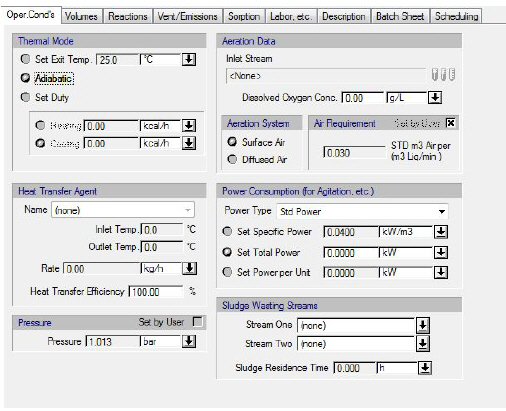

The following table shows a brief description of the variables appearing in this tab. The table also displays their default values and their generally acceptable range:
|
Variable |
Default Value |
Range |
|
|
||
|
◙ Final Temperature (oC) |
25.0 |
Positive |
|
◙ Heating Duty (kcal/h) |
0.0 |
Positive |
|
◙ Cooling Duty (kcal/h) |
0.0 |
Positive |
|
○ Heat Transfer Agent Name |
<Steam> |
Any Heat Transfer Agent |
|
● Inlet Temp. (oC) |
152.0 |
Positive |
|
● Outlet Temp. (oC) |
152.0 |
Positive |
|
● Rate (kg/h) |
0.0 |
Positive |
|
○ Heat Transfer Efficiency(%) |
100.0 |
[0,100) |
|
○ Pressure Set by User |
No |
Yes/No |
|
◙ Pressure (atm) |
1.0 |
Positive |
|
○ Aeration Inlet Stream |
<None> |
Any Input Port |
|
○ Dissolved Oxygen Conc. (g/L) |
0.0 |
Positive |
|
○ Air Requirement Set by User |
Yes |
Yes/No |
|
◙ Air Requirement (m3 Air per m3 Liq/min) |
0.030 |
Positive |
|
○ Power Type |
<Std Power> |
Any Power Type |
|
◙ Specific Power (Per Volume) (kW/m3) |
0.04 |
Positive |
|
◙ Total Power (kW) |
0.0 |
Positive |
|
◙ Power Per Unit (kW) |
0.0 |
Positive |
|
○ Sludge Wasting Stream One |
<None> |
Any Output Port |
|
○ Sludge Wasting Stream Two |
<None> |
Any Output Port |
|
● Sludge Residence Time (h) |
0.0 |
Positive |
Symbol Key: ○ User-specified value (always input); ● Calculated value (always output); ◙ Sometimes input, sometimes output
The following list describes the available specification choices in this tab; for more details on how these are implemented, see WM Stoichiometric Aerobic Bio-Oxidation: Modeling Calculations.
•Aeration Options...
You may select between Surface and Diffusion Aeration. For diffused aeration, you may set the air requirement (in m3 air/ m3 liq-min) and that in turn is used to adjust the flowrate of the aeration stream.
•Sludge Data...
The Sludge Wasting Streams are the stream in the activated sludge loop through which the sludge is removed from the loop. These are typically the effluent stream and the stream that leads to the sludge treatment section. The flow of sludge in the sludge-wasting stream(s) is used to calculate the average sludge residence time in the activated sludge loop.